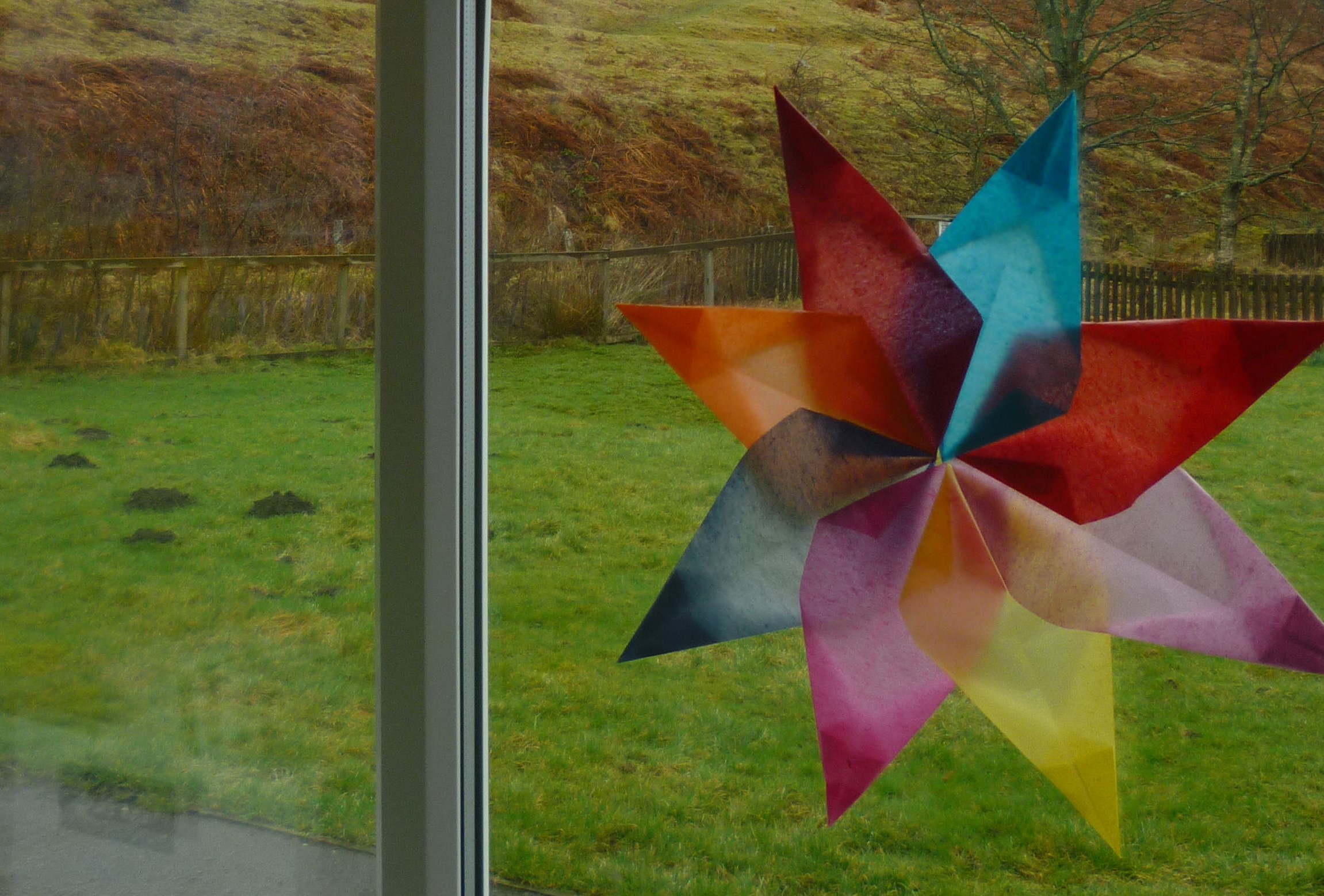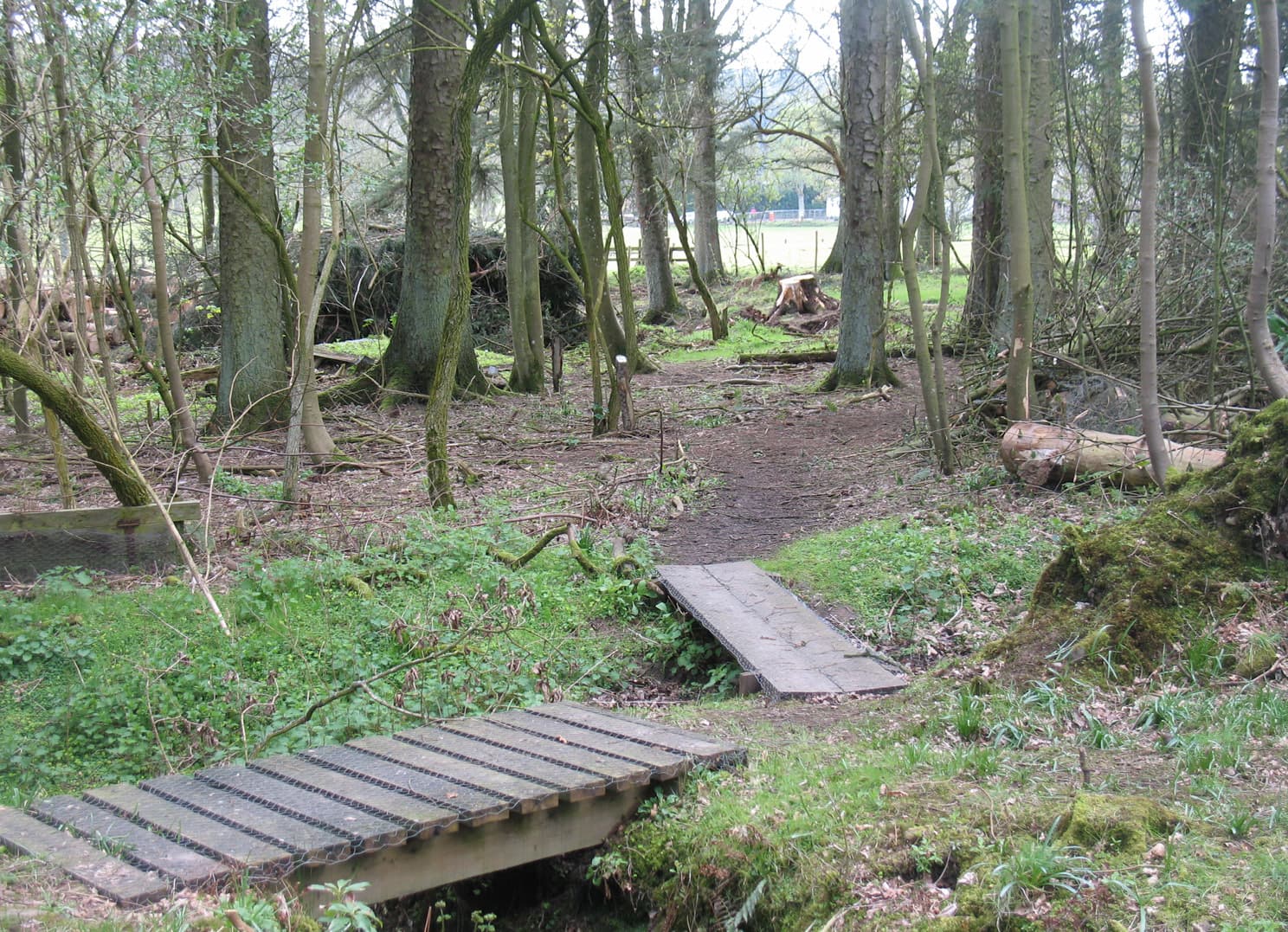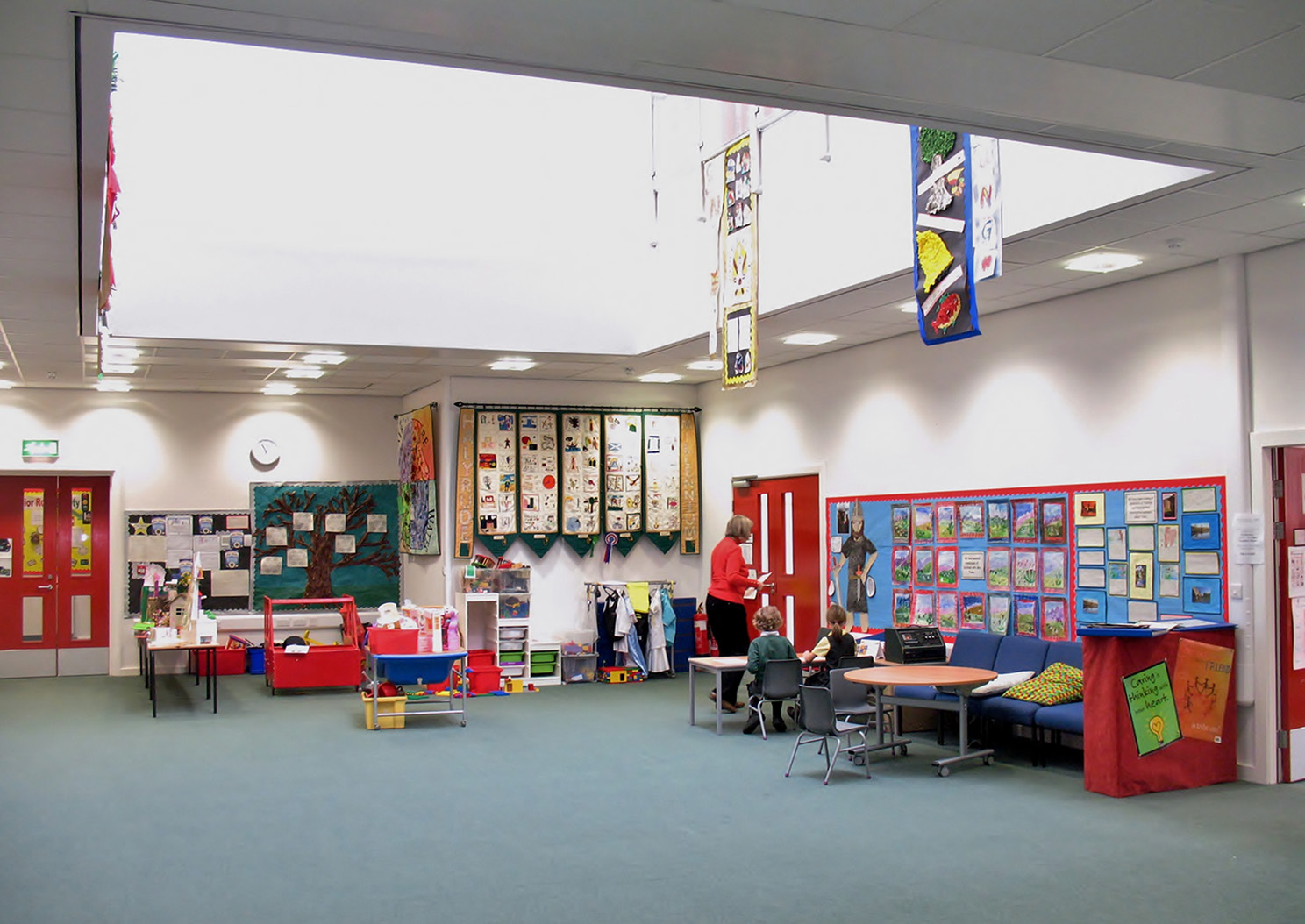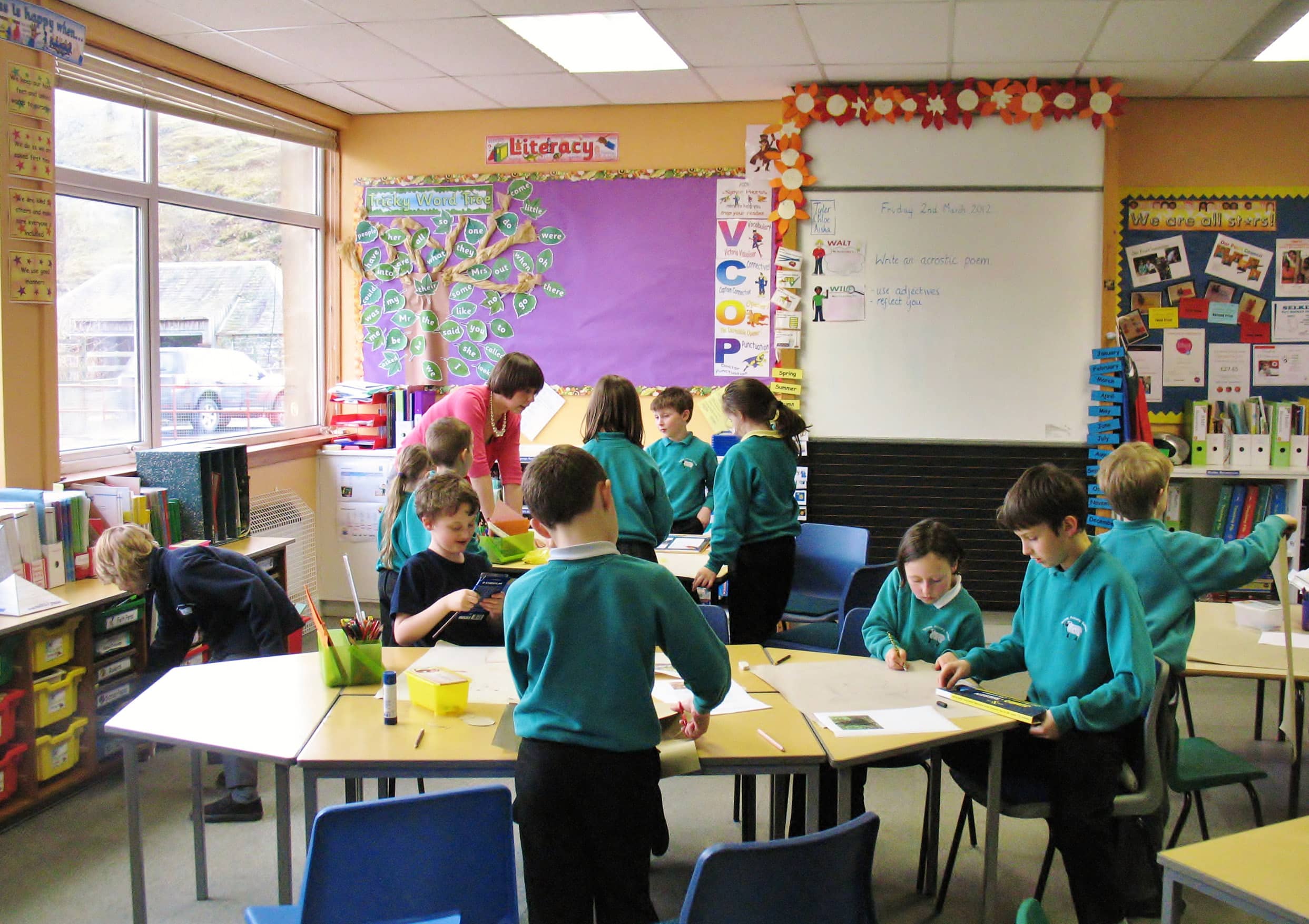Small school design
Learn about how three small schools in Scotland designed the right learning environment for their students and staff.

At Architecture and Design Scotland we believe in the importance of well-designed environments in educational places. This belief is found by seeing first-hand how students and staff benefit from positive learning environments by providing them with the best experience throughout their academic and vocational journey.
By seeking out the voices of people that use your learning environment, you can develop educational places that benefit your students and staff.
What this case study includes:
We visited three schools in Scotland and developed three case studies for you to learn about the benefits of outdoor learning spaces, open and dynamic spaces, and collaboration.
In these case studies you can learn how:

St Mungo Primary: learning forest
St Mungo Primary is a small school in a listed converted church on the outskirts of the village of Kettleholm in Dumfries and Galloway. Its recent refurbishment has refreshed the building and given a new lease of life to the school building and the small community of 34 pupils.
Image credit: Antonia Cairns
The school has access to a forest garden which is located a few hundred metres away in local estate land. Children are regularly taken out of the school and accompanied into the woods for outdoor ‘learning in the forest’ days.
The completed refurbishment included:
- a services upgrade
- internal and external decorations
- secondary glazing
- internal modifications such as layout and arrangement of spaces
Key learnings
Inside the school, the refurbished spaces are pleasant, light, and cheerful places to learn and work. There are two large, bright, and airy classrooms, with high ceilings up into the apex of the church roof.
“It is lively and bright here, everyone who comes into the space benefits. We really do appreciate it.” – Headteacher
The children learn in combined classrooms with an overall capacity for up to 45 students at the school within the two classes.
Outside of the classrooms there is a small linking ‘learning corridor’ furnished with computers for ICT learning, plus a small open library space near the entrance lobby for reading and quiet work.
There is a long-term Portakabin located at the rear of the school, used as a dining hall, music, art, and recreation space.
There are large stores for school resources in the Portakabin and a mezzanine area. With ample storage, the classrooms can remain clear, open and clutter-free spaces for learning.
Once a month, in all weathers, the children go into the woods for an outdoor learning day. The forest offers new ways of learning and stimulates creativity beyond the classroom or even the playground.
Outdoor classes
The school has an established classroom area with named benches for outdoor lessons. The children have been involved in building the class benches, bridges, and stiles. They have a great sense of pride and ownership of their woods.
The breadth of learning activities in the forest has included den building and a series of wildlife and environment projects with a local ranger from Annandale and Eskdale.
The forest is an ideal size, and the children have a great deal of freedom compared with school outings to public spaces. The forest is surrounded by fields which has a natural edge, making it easy for the children to understand their boundaries and behave responsibly.
There is ample outdoor space for play and learning on school grounds. The school provides generous outdoor learning resources at hand to make it easy to take lessons outdoors. These include:
- a playground with a climbing area, outdoor games tables and sheltered areas with outdoor toys
- highly personalised outdoor space with children’s art and murals, colourful footprints, and painted patterns on the ground
- a large grass games field at the back of the school which is used for football and other sports activities
Capturing imagination
The children came up with a motto, “We may be small, but we have got it all”. They gravitate towards certain spaces for imaginative play such as:
- the nooks and crannies and sheltered and tucked away spaces
- the ‘in-between spaces’ like the area of fencing and trees between two buildings
- linking spaces that connect areas of the playgrounds, that the children can pass through
- a little dead-end of a brick enclosure that the children call ‘the dungeon’
Takeaways and highlights
The introduction of Curriculum for Excellence has been an easy adaption. At St Mungo Primary, they find there is a good relationship between the children across age groups. While there are enough children to support a good social mix, every child can still be known as an individual.
Key takeaways and highlights from St Mungo Primary:
- The children benefit from the opportunities of having a variety of outdoor experiences, particularly for their health, wellbeing, imagination, and learning
- The possibility for the children to work together helped grow a collective sense of community, pride, and responsibility
- The bright and airy learning spaces and freshly painted exterior are important aesthetic aspects of school design
- Looking beyond the classrooms and school walls enabled the school to find inspiring learning opportunities for its pupils
- This school provides a richness of learning and life experience through variety, freedom, community, and a collective sense of responsibility
“If you asked any of the children what the best thing is about the school, they would all say learning in the forest.”

Halyrude Roman Catholic Primary: the heart of the school
Halyrude Roman Catholic Primary School is a small school in the town on Peebles. The school building, formerly Kingsland Primary School, was substantially re-modelled for the arrival of the new community of learners, which includes the Tweeddale Support Centre and pre-school learners in the Rosetta Playgroup.
Image credit: Antonia Cairns
The Tweeddale Centre, catering for young children with complex learning needs, is located right in the centre of the building and is well integrated with the school, sharing use of all the common learning spaces.
The re-modelled school provides a more open and dynamic environment centred around a double height top lit space. The school holds 89 students, but there can be around 100 children using the building at any one time.
Although organisationally separate, the communities share common spaces such as the gym space, dining hall and playgrounds.
Key learnings
The re-design of this two-storey building is centred around a large double height gathering space in the heart of the school.
This top-lit space, the original atrium within the Victorian building, had been concealed for many years while occupied by Kingsland Primary. This generously proportioned space has been re-instated with architectural features of roof trusses.
Glossary | Roof truss: A structural framework of timbers designed to bridge the space above a room and provide support for a roof.
The atrium is known as ‘St Joseph’s’, after the original primary school in the local area. It provides a bright and airy gathering space, an ‘open heart’ for the whole school community to flow through.
“Everything we want to do together, we do in St Joseph’s. It really is the heart of the school” – Headteacher
The atrium consists of two floors. The upper level includes a small library area with the lower level used throughout the day for:
- a mixture of break-out activities
- group work
- active learning
- quiet activities
Over the course of the day the dynamics of St Joseph’s change. The overall space provides the school with the opportunity of an intimate educational setting, despite being busy at times.
The centre or ‘heart’ of the school ensures a continual use and natural ‘ebb and flow’ of the school community.
The generous scale of the St Joseph’s space enables it to be used for large group gatherings, congregation, celebrations of achievement and worship.
It is used to support curriculum delivery in new ways, such as ‘whole school learning’ with children working cooperatively and collaboratively across age groups in one big communal space.
There are six classrooms, plus a learning support room all located off the central space. The layout of the classrooms are largely based on the original school layout from the 1900s with modifications made to enable learning in a more open and fluid way.
The classrooms are bright, modern, and spacious learning spaces that flow directly into the central gathering space.
They also have wide openings into the atrium with no doors except on the Tweeddale Centre. But while the atrium can be a lively and noisy environment, the classrooms are acoustically sheltered.
The arrangement of semi-open classrooms around the atrium provides a good balance of open-ness and privacy, interaction, and focus.
The classrooms’ deep alcoves provide recesses for storage and equipment. In combination with lowered ceilings these act as a buffer to the noise and activity in the central space.
The bright, modern classrooms provide a range of furniture for the mixed age groups with ample wall space for display of work, storage, whiteboard, projection, interactive whiteboards, and pinboards.
“They particularly enjoy the space they have to embrace fully all the learning activities offered through a Curriculum for Excellence.” – Headteacher
As well as the central atrium space, the students also benefit from a separate dining hall and gym hall.
This separate gym hall and dining space is valued within the school as it enables the delivery of subjects like physical education and music. The new spaces provide less disruption than the previous multifunction space.
The spaces are clearly zoned into a learning area, administrative area, and gym / dining areas. All the areas are clustered in a manner that is logical and easy to use and navigate.
Although there are six classrooms, the current school role supports four classes (three composite plus a dedicated primary seven class).
The school makes use of the unoccupied classrooms for activities like art and computer work. In this school building, there is ample space to work without disturbing others in lessons.
Throughout the school, staff and pupils benefit from a quality and generosity of space. Teaching staff have a meeting room, separate staff room and ample support space for equipment and learning materials.
Using all the spaces did not come easily at first. With a variety in scale and choice of spaces compared to the previous building, the school needed a period of adjustment to adapt and find ways to take advantage of the building.
“Staff and children had to grow into the space, some of the young children found it quite difficult to come to terms with the vastness. Now we love the opportunities the space provides.” – Headteacher
The generosity of space extends beyond the school walls and into the outdoor learning spaces. The play space is quite extensive. For supervision reasons, the school contains play to the area at the rear of the school.
There is also a small garden which provides a more intimate space for this small school community. The school plans to have the garden landscaped in the future to provide students with better outdoor space for learning and play.
Takeaways and highlights
There are several ideas that work well at this small school, benefiting this community of learners and enabling delivery of the Curriculum for Excellence.
Key takeaways and highlights from Halyrude Roman Catholic Primary:
- Create learning environments with plenty of natural light and a sense of space and openness
- Develop schools that enable and encourage a natural ebb and flow of learning, by offering choice and fluidity
- Design inspiring buildings that foster creativity
- Offer gathering spaces that are central and open and use the open heart to foster community
- Provide spaces to support collaborative learning
“We have a great range of spaces available to work in that enables us to work more effectively, more timeously. The central space in particular provides these choices in a fluid way: you can be in or out, be part or not be part.”

Trio of small schools: connections for learning
This trio of small rural schools (Ettrick, Yarrow and Kirhope Primaries) are located near Selkirk in the Scottish Borders. The three schools are located across two valleys, with thirty miles of country roads linking the communities. They joined up in 2009 and maintain a close relationship through a carefully planned programme of collaborative working throughout the year.
Image credit: Antonia Cairns
What are the schools involved?
Ettrick Primary
Built in 1964, the school is situated in the heart of the Ettrick community and the smallest of the trio of schools. It has excellent and generous outdoor learning spaces with gardens and wildlife areas, and an ‘outdoor classroom’ in the playground.
Yarrow Primary
Built around 1971, the school is situated in the small village of Yarrow approximately nine miles from Selkirk. The school has ample outdoor space for the children to enjoy, with good recreation spaces, play space, a garden and, an outdoor classroom which is enjoyed in the finer weather.
Kirkhope Primary
Built in 1874, the school is situated in Ettrickbridge, a small village approximately seven miles from Selkirk. As the largest of the three Schools, Kirkhope is located on a constrained site, with two extension development over the years. It has a smaller playground which requires a rota for use of the main playground area.
Key learnings
Collaboration days are planned, as and when it fits with the curriculum and are weather dependant.
The staff and pupils come together at the host school for a day of theme-based, cross-curricular activities, making full use of this time with their peers. This allows pupils to work with others at the same age group, working as part of a larger cluster.
In addition to their collaboration days, wider learning initiatives such as ‘Generation Science’ have provided further opportunities and funding for shared learning activities across the schools.
The schools regularly join up for sports at Kirkhope Sports Field and programmed activities such as Rugby or Gymnastics in Selkirk. As required, they use community facilities such as local theatres (Eastgate and Bowhill) as well as community halls, churches and sports fields.
All these face-to-face interactions across their communities provide opportunities for new learning and form social bonds.
The schools are also exploring more virtual collaboration across the three schools.
As the emerging curriculum demands activities like discussion, debate, and chairmanship, it can be difficult to support these in very small schools.
At the time, the school recently started using ‘Glow Meet’. There is hope that this will help them achieve better delivery of joined up programmes, both in terms of student connections and staff co-ordination on preparatory work.
Between the schools, they run ‘The Valley’s Wee Paper’ launched in September 2011. The paper includes some historical research, new articles and features activities in the schools and community.
As well as fun activities for the pupils, the paper helps to capture and share community connections from past and present times.
At the time of the visit, other than the recent Nursery extension at Kirkhope, none of the schools have been adapted in any significant way since their construction.
They’ve all had maintenance and minor decorative uplifts over the years. The three schools provide four main types of space inside the buildings:
- A ‘welcome space’ or lobby which is the semi-public area of the school and provides information boards and some space for parents, pupils, and staff to mingle
- The ‘classrooms’, one at Ettrick and Yarrow Primaries and two at Kirkhope Primary
- A ‘multi-purpose learning room’ for all other activities including dining, music, art, ICT and ‘break out’ learning
- An ‘admin space’ with a small office area and resource store
The classrooms have a range of appropriately sized tables and chairs in relation to the age groups.
The walls are equipped with the required learning equipment such as white boards and provide pin up space for display of children’s work. Learning reference materials on the walls range from phonics displays for early years children to research projects for older pupils within a single space.
Many of the classrooms have large windows with beautiful views, but these do limit the available space for pin-up and can sometimes cause glare and bleaching of students work due to direct sunlight.
Pin up space inside the classrooms is a key aspect in all three schools. Observation is that in these small schools the need for display space has exceeded the requirements of typical ‘year-based’ classrooms in larger schools.
At Ettrick there is a concertina (folding) door between the classrooms which in the past was used to open the space up for larger group activities. In recent years the folding wall door has remained closed as the need for pin up space has outweighed the need for flexibility.
At Kirkhope the shortage of pinup space arises from the building configuration, with through-routes and many doors, together with the built-in storage in the rooms further limiting display space on the walls.
The children at all three schools work in mixed age classrooms and have a broad range of learning abilities and social skills. There is frequent need for ‘break out’ activities to support their learning, which take place in multifunction rooms.
These spaces are used in parallel with the main classrooms throughout the course of the day.
The multifunction room provides for all learning and social activities outside of the classroom. These include dining, art, music, ICT, and breakout space.
These spaces typically provide a mix of settings such as:
- fold-down dining tables and a servery hatch provide for dining
- mixed sizes of tables and chairs for breakout
- learning resources in storage of all types
- office equipment such as photocopiers
- ICT benches for computer work
- sink areas and easels for art and wet work
- play space and equipment for early years
- assorted props for a range of subjects including potted plants, musical instruments and sewing machines.
In Kirkhope Primary, the multifunction room is accessed directly off one of the classrooms. While the organisation of the space isn’t ideal, it has led them to find ways to create additional break out space in the corridors to minimise disruption.
The multifunction room includes a library, a table for small group or one-to-one work and prep work, a photocopier and resource area.
Driven by the limitations of the existing space, Kirkhope have created a mixture of spaces for small group activities. This provides opportunities for pupil led learning to happen more easily, making use of “every nook and cranny” in the building.
Looking at the multifunction spaces across the three small schools, what is most immediately apparent is the diversity and quantity of loose furniture for all sizes of learners.
Within the classrooms the furnishings are ‘zoned’ into clusters of tables for age groupings. This is less easily organised in the multifunction and mixed-use areas.
In these rooms you see tiny and large chairs, side-by-side and stacked, alongside a mixture of scales of office storage, furniture, and equipment.
At Kirkhope Primary, there was a particular mismatch of the scale. The fitted furniture around the perimeter of the ‘juniors’ classroom had been originally designed for use by the ‘seniors’.
Over the years, the use of the classrooms had swapped over. At the time, the young pupils were in a classroom with larger units against the walls. This meant that they are unable to reach over the tops of the units, to pin up (or interact with) the materials on the walls.
Takeaways and highlights
Many of the challenges and opportunities around how you make best use of space are common with larger schools, while others are quite particular to a small school setting.
Staff agreed that providing of a good range of spaces is vital in small schools, as not all learning can be supported in the classroom.
Key takeaways and highlights include:
- Provide ‘versatile’ spaces that support a diversity of activities including dining, breakout, sharing, formal and informal working
- Create familiar spaces that are thoughtful and comfortable with a ‘non-institutional’ feel
- Provide ‘interactive learning walls’ at accessible heights for students to pin up work, statements of intent and evidence of improvement
- Create settings that cater for all ages and sizes of learner, as infants and seniors often share the same spaces
- Provide spaces that can store learning resources and furniture as a neat storing solution to create more spaces for learning
- Create a good arrival experience and a welcoming space for interaction and mingling, with display space for school and community news
- Get students involved in the design of the space and decorative changes to their school
- Make the most of mobile technology, including IT at the desk to enable easier learning and to free up space for other uses
- Be creative with spaces and use every nook and cranny—having less space enables schools to be smarter and more creative with what’s available
- Provide a private space for meetings and staff breaks away from the classroom and office areas
- Consider semi-open building types that create feelings of enclosure, allowing open interaction, and enabling people to be ‘in or out of the action’
- Provide access to a gym space or a space which is flexible enough for exercise use in the school or local community
“The most useful tools for schools would be ideas for creative use of space and the creative re-use of readily available resources...It would also be useful for children to participate in improving their spaces. They could help us to know how to make it better.”
Header image credit: Antonia Cairns
Our work on people, places and learning
We are currently supporting the Scottish Government and collaborating with Scottish Futures Trust to help anyone involved in design proposals for learning estates across Scotland by sharing our learnings, co-ordinating advice and supporting local authorities.
If you are looking for resources or need a helping hand in improving learning spaces, visit our schools page for more information.
